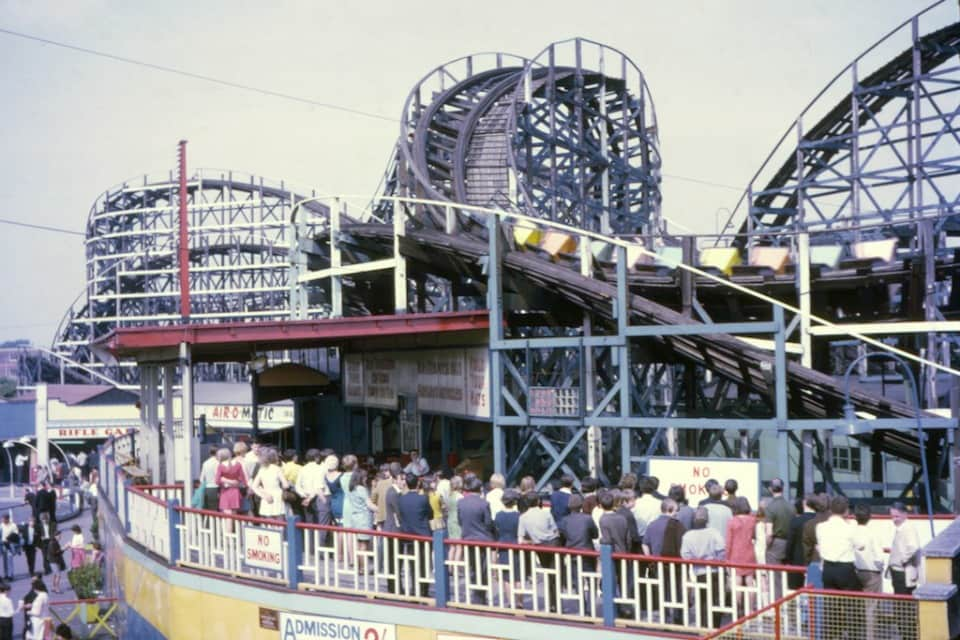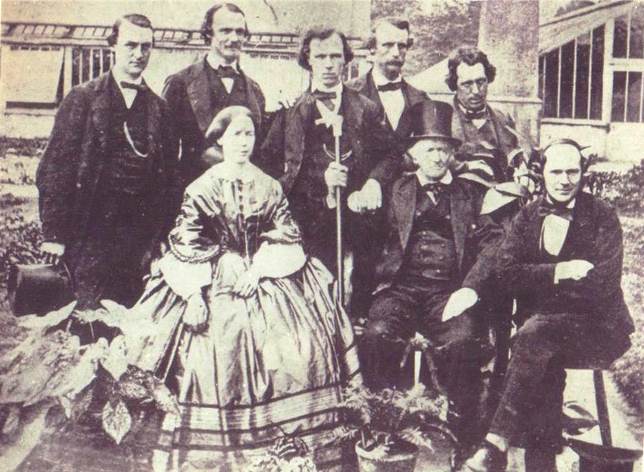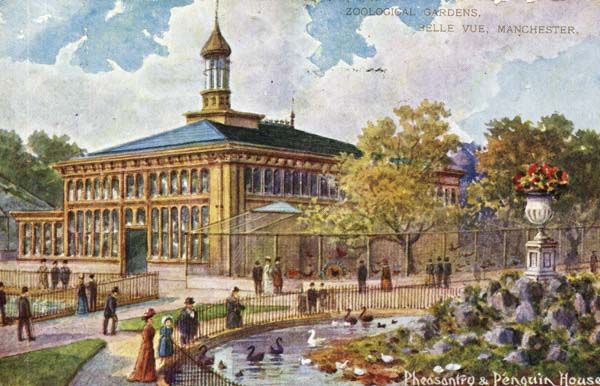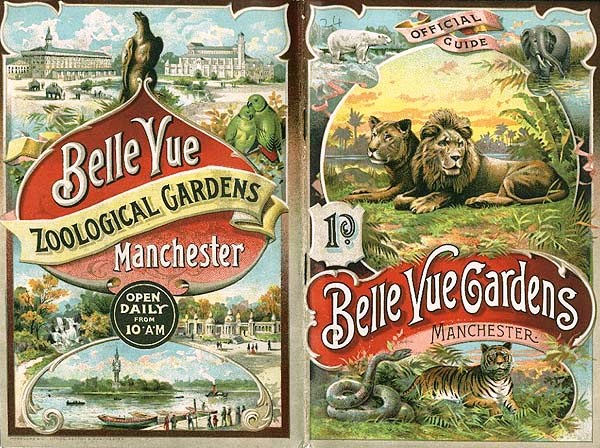 Crowd scene at fairground rides at Belle Vue Gardens, Manchester, 1968
Crowd scene at fairground rides at Belle Vue Gardens, Manchester, 1968
Belle Vue
From time to time one of the talks in our programme strikes a chord with the wider community. So it was with our December talk about Belle Vue, given by Brian Selby and Frank Rhodes. As well as a good attendance of our regular members, we had twenty five visitors come to recollect something of their childhood. Brian and Frank were an effective double act. Brian was the amateur enthusiast; Frank was the historian. Brian did most of the talking whilst Frank relayed many of the anecdotes and legends that have grown up around the iconic amusement park.
 Jennison family portrait at Belle Vue Zoological Gardens, 1850For much of its existence Belle Vue was a family firm and the founding father was John Jennison. Originally from Nottingham, he moved to Adswood as a young man where he worked as a part time gardener. In order to augment his income he opened his garden to the public, calling it ‘Strawberry Gardens,’ selling vegetables and offering drinks and afternoon tea. It was popular and he developed the idea by adding a small aviary and introducing some monkeys and other small mammals.
Jennison family portrait at Belle Vue Zoological Gardens, 1850For much of its existence Belle Vue was a family firm and the founding father was John Jennison. Originally from Nottingham, he moved to Adswood as a young man where he worked as a part time gardener. In order to augment his income he opened his garden to the public, calling it ‘Strawberry Gardens,’ selling vegetables and offering drinks and afternoon tea. It was popular and he developed the idea by adding a small aviary and introducing some monkeys and other small mammals.
In 1835 he made the big leap and leased Belle Vue, a public house with 35 acres of open land in Gorton. At its opening the following year there was an Italian Garden, some small lakes, mazes and hot houses as well as the aviary. It proved popular and many other attractions were quickly added. Perhaps too quickly because by 1842 he was in financial difficulties and bankruptcy proceedings were started. However, his creditors allowed him time to make a success of the venture and he soon began to pay off his debts. The business thrived, helped by the new railways bringing in visitors and the bankruptcy of a rival establishment in Salford.
 The Great Exhibition of 1851 gave Jennison many ideas that he incorporated into Belle Vue’s offering. Brass band competitions, fireworks, battle reenactments and outdoor dancing all became popular fixtures at the Gardens and he employed the scenic artist who had created dramatic scenes in London. There were also special one-off attractions such as a Spanish aeronaut (who was probably a local man in disguise) in a balloon. The emphasis was always on entertainment and novelty.
The Great Exhibition of 1851 gave Jennison many ideas that he incorporated into Belle Vue’s offering. Brass band competitions, fireworks, battle reenactments and outdoor dancing all became popular fixtures at the Gardens and he employed the scenic artist who had created dramatic scenes in London. There were also special one-off attractions such as a Spanish aeronaut (who was probably a local man in disguise) in a balloon. The emphasis was always on entertainment and novelty.
John Jennison died in 1869 but his family carried on the business and expanded it though responsibilities were split. The zoo was developed and the business had a keen eye for publicity. When they bought an elephant from a defunct zoo in Edinburgh for £680 (£73,000), the railway company refused to transport it after it destroyed the roof of the goods wagon it was occupying. Maharajah and his keeper then walked to Manchester over a period of ten days, generating enormous publicity enroute. A large lake was dug using the existing ponds and this offered boat rides as well as water battles and a background to the regular firework displays which
However, despite increasing numbers coming to the various attractions the second generation of the family struggled to develop the business. There was no single leader and various promising innovations conflicted with each other. Some wanted a higher class of garden and elegant restaurants; others were developing an athletics stadium which became a speedway track. Some began to develop various amusement rides and attractions. It was very much a big business and virtually self-sufficient. It had a range of repair facilities, maintenance and security staff, its own power sources, water supp ly and other utilities. In many ways it was a city within a city.
ly and other utilities. In many ways it was a city within a city.
In 1924 the family decided to sell their interest and the new management developed the amusement park. Under the Jennisons the main prioroties had been the zoological and botanical gardens but the emphasis began to change. The iconic “Bob” roller coaster was erected (so-called because it cost one shilling for a ride) and other attractions such as the “Caterpillar”, the scenic railway and Dodgems were brought in.
The venture prospered throughout the Second World War and well into the 1960s but it was gradually losing its way commercially. It was sold to new owners including Charles Forte in 1957. Various new ventures were tried and old ones revived but there was no consistency, no continuity. The land was more valuable than the enterprise occupying that land and Belle Vue closed for good in 1980. Some of the ventures carried on under separate ownership such as the Kings’ Hall, the speedway and one or two of the restaurants but the heart had gone out of the business. There is little there now to show what once was a vibrant social attraction for a hard working city. British Car Auctions somehow does not compare with the Kings’ Hall or Fireworks Lake.
For those who have childhood memories of the miniature railway have a look at the blog on the Chetham Library site by one of the drivers of the miniature railway:
http://library.chethams.com/blog/belle-vue-miniature-railway-a-beloved-attraction-remembered/
and, if that’s not enough, you can also read his blog on the demise of the scenic railway:
http://library.chethams.com/blog/the-belle-vue-scenic-railway-our-special-correspondent-writes/
Enjoy!

